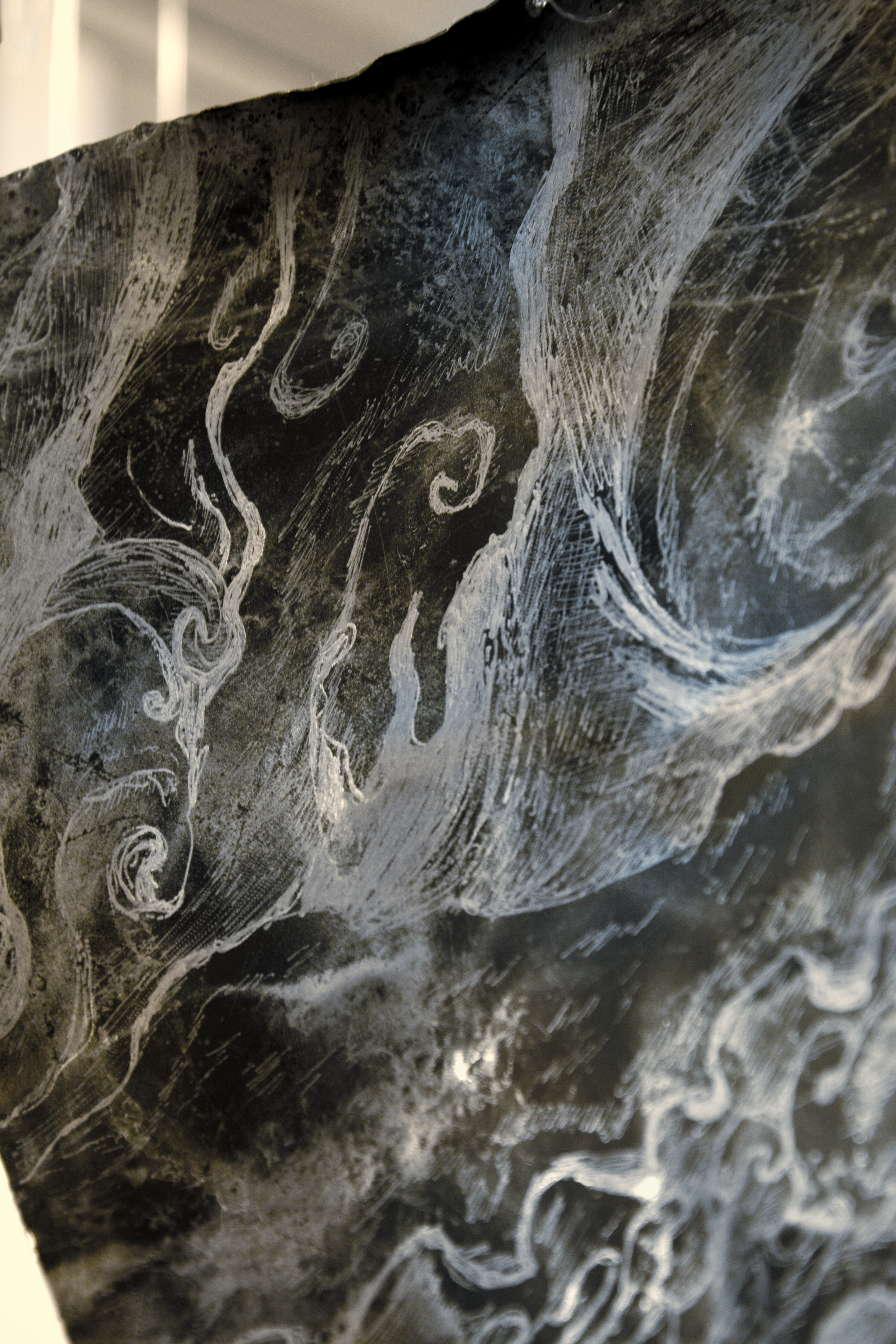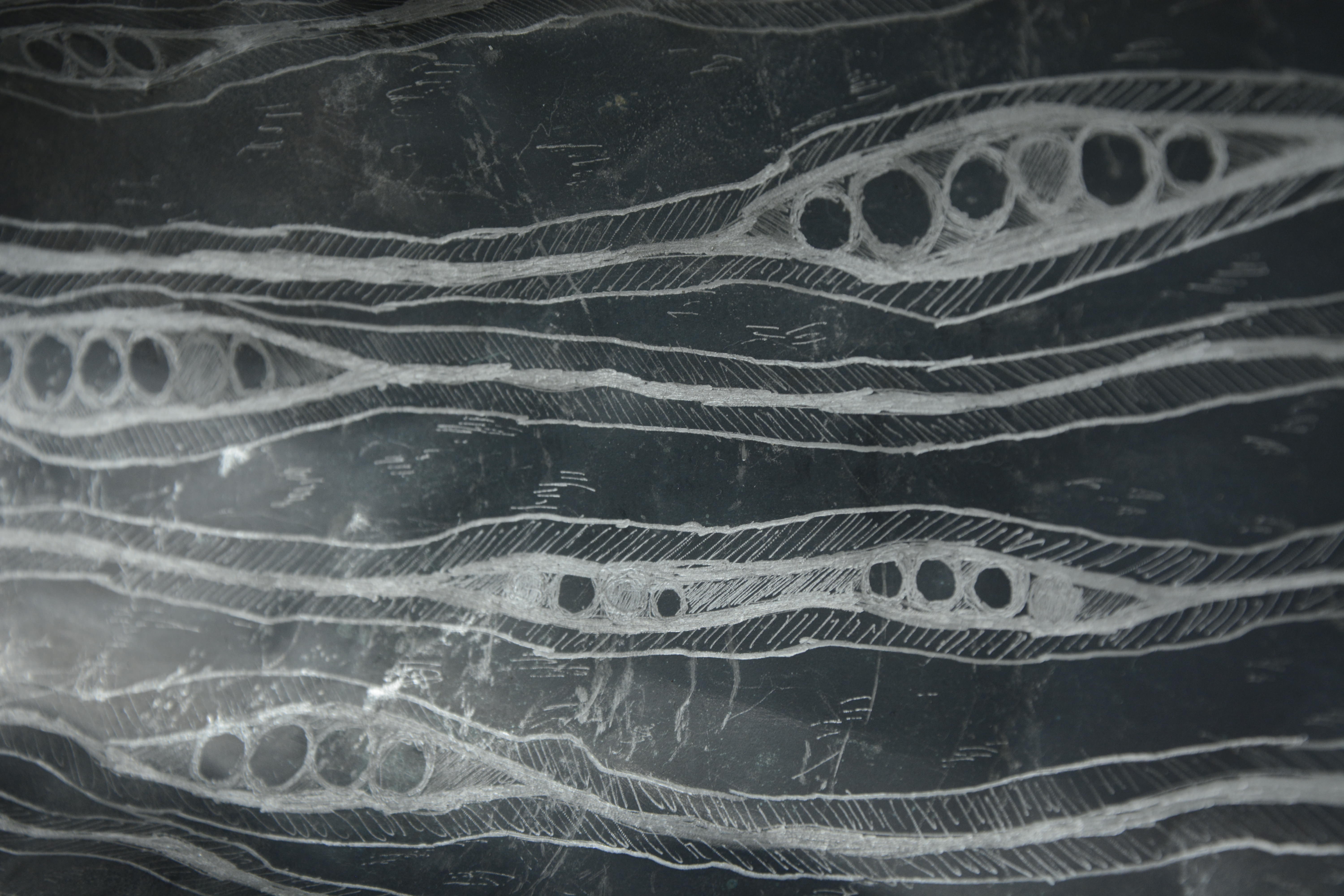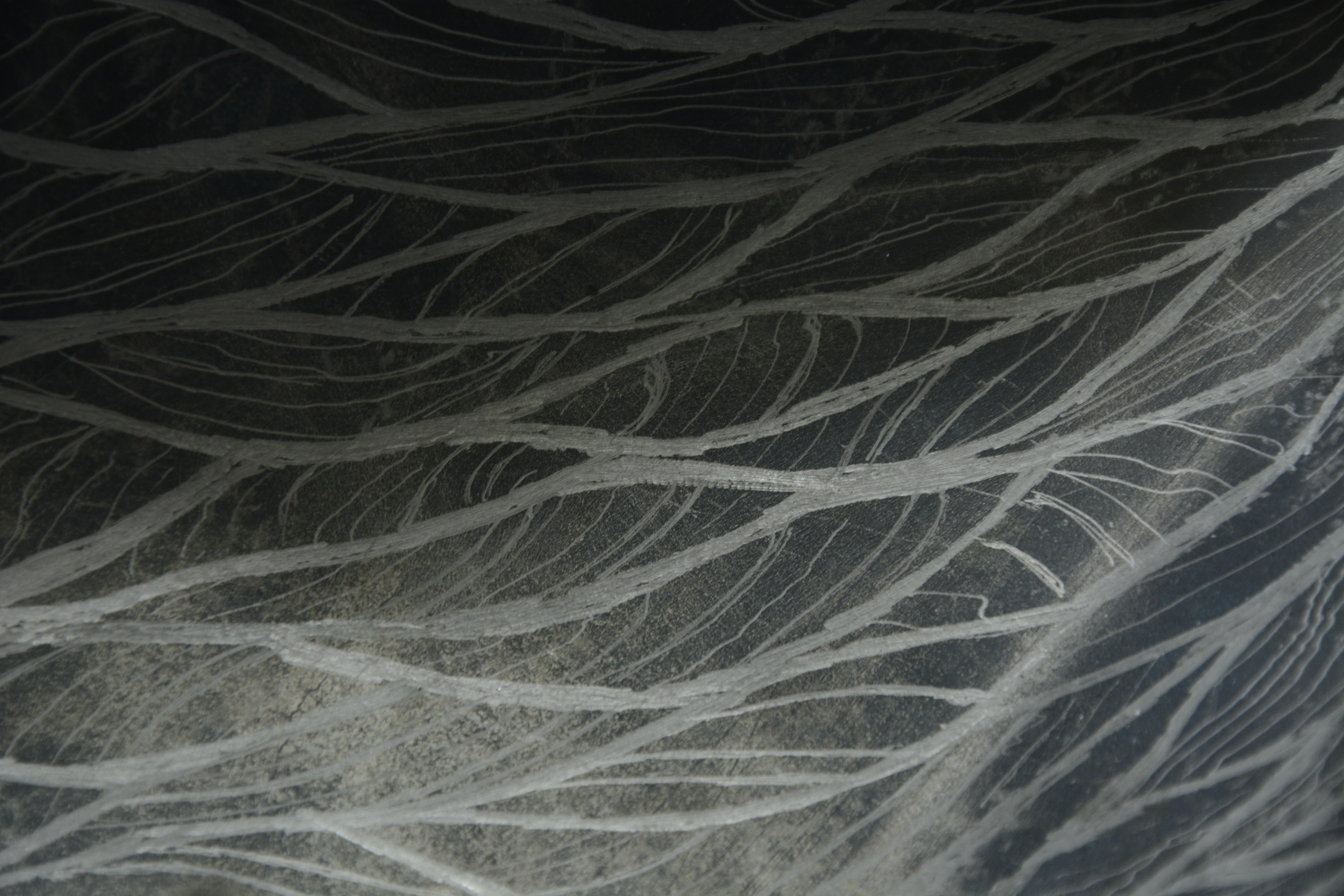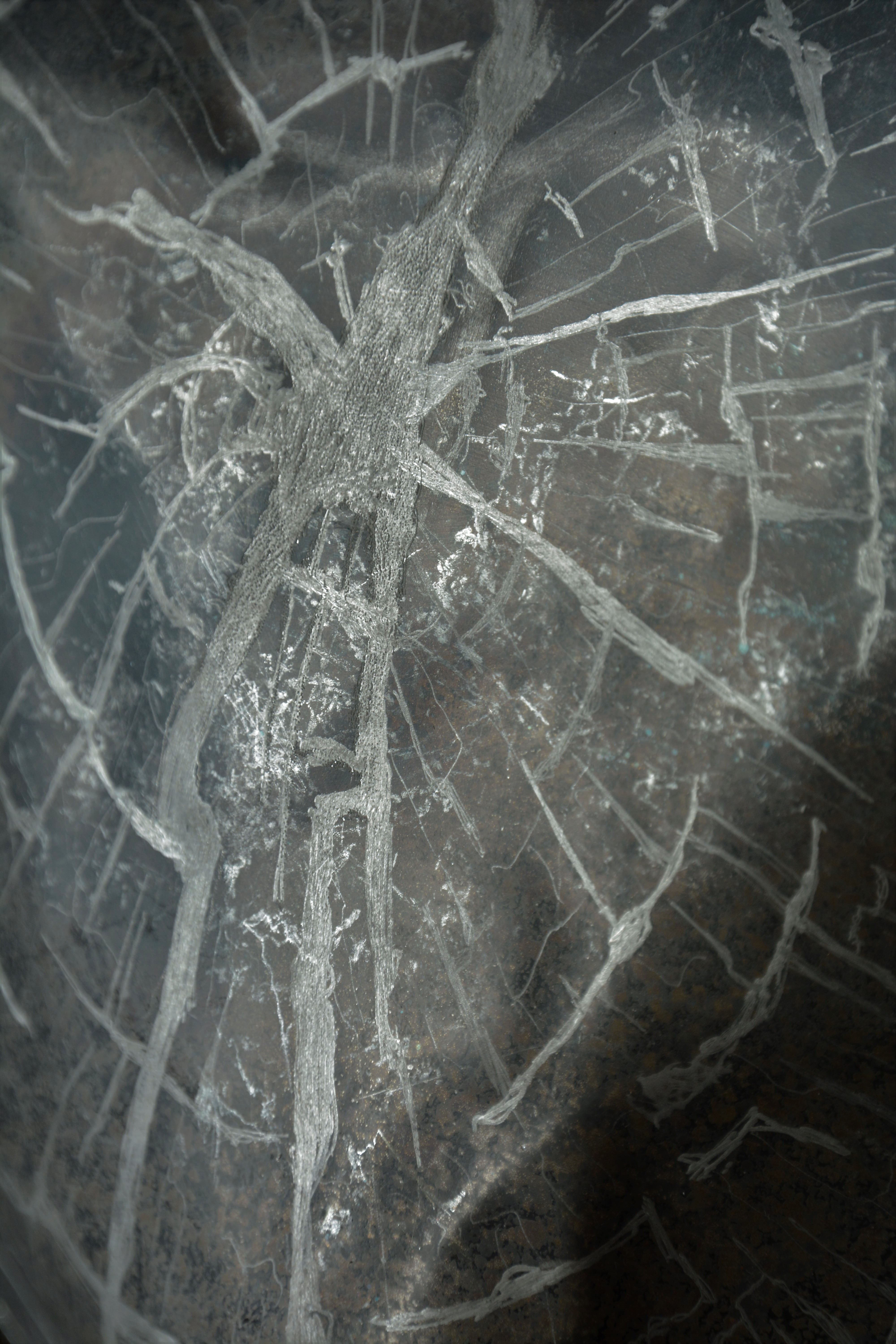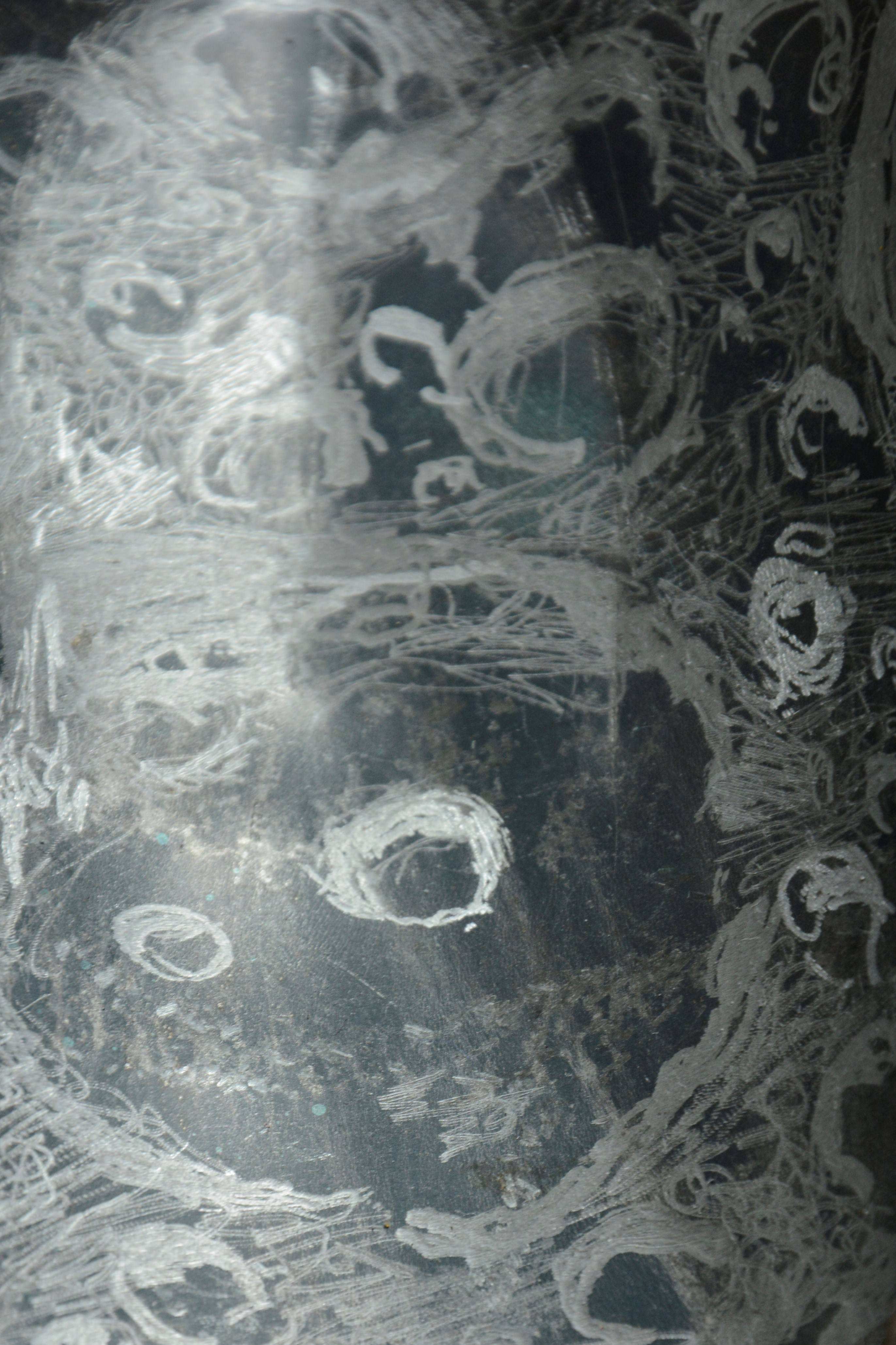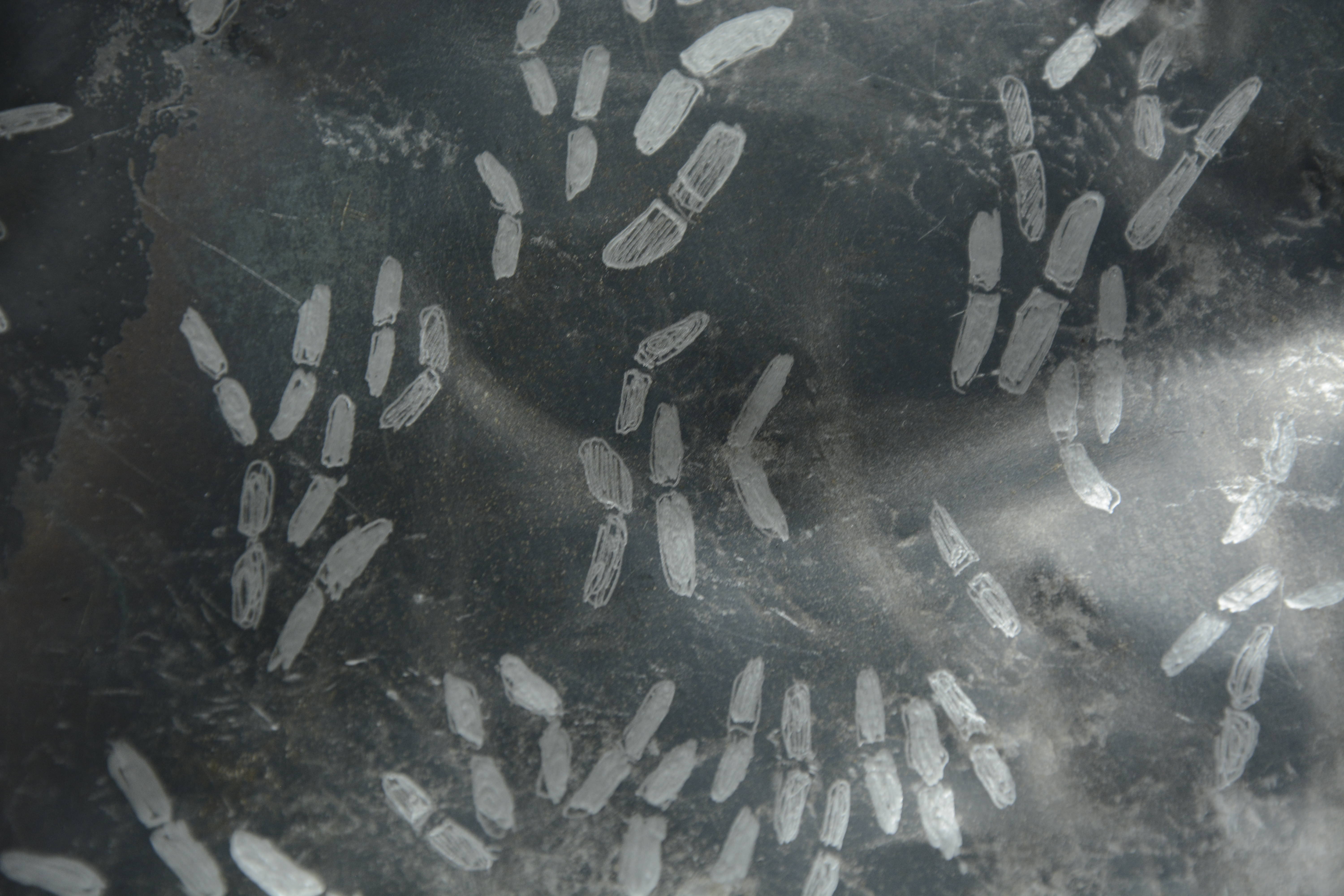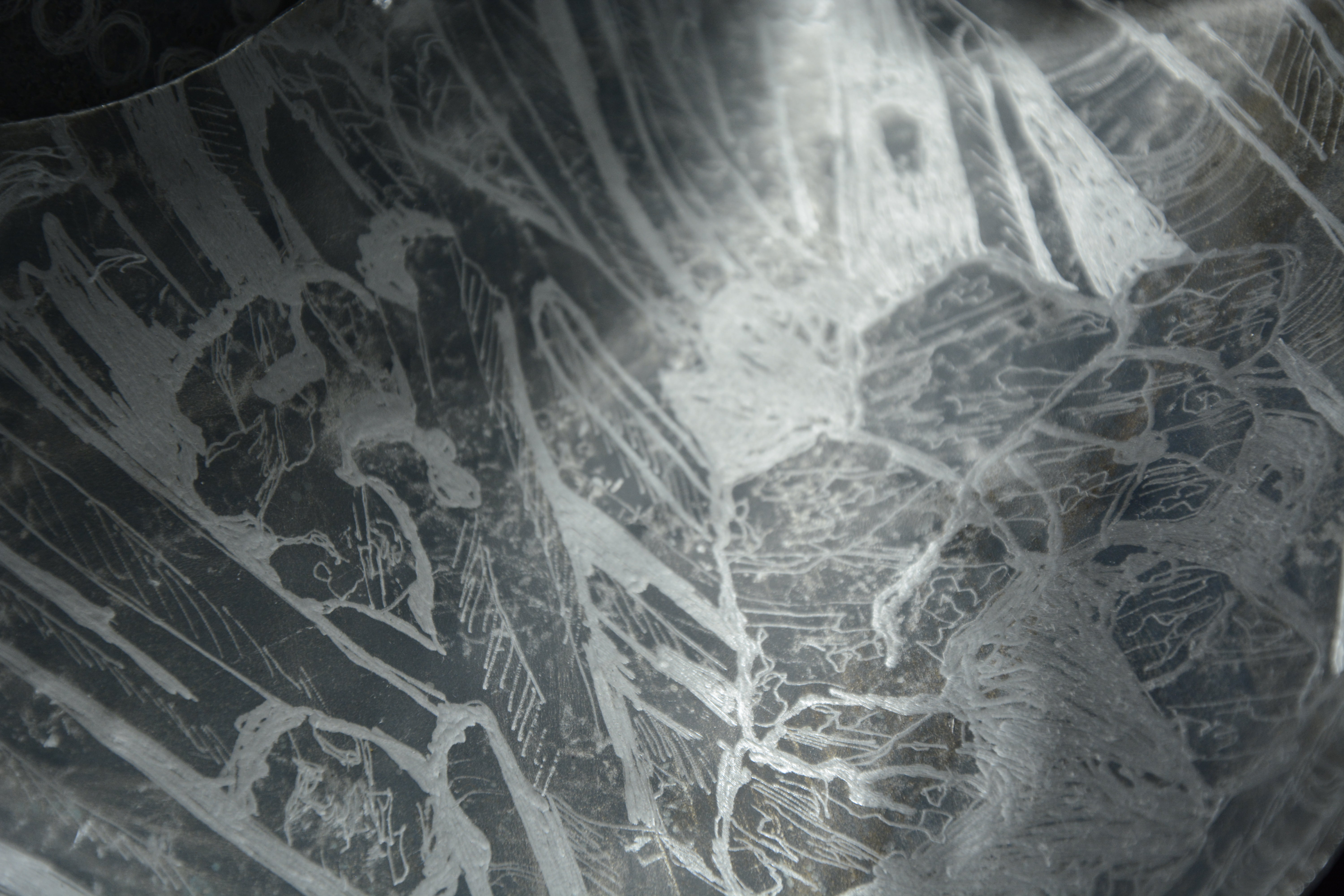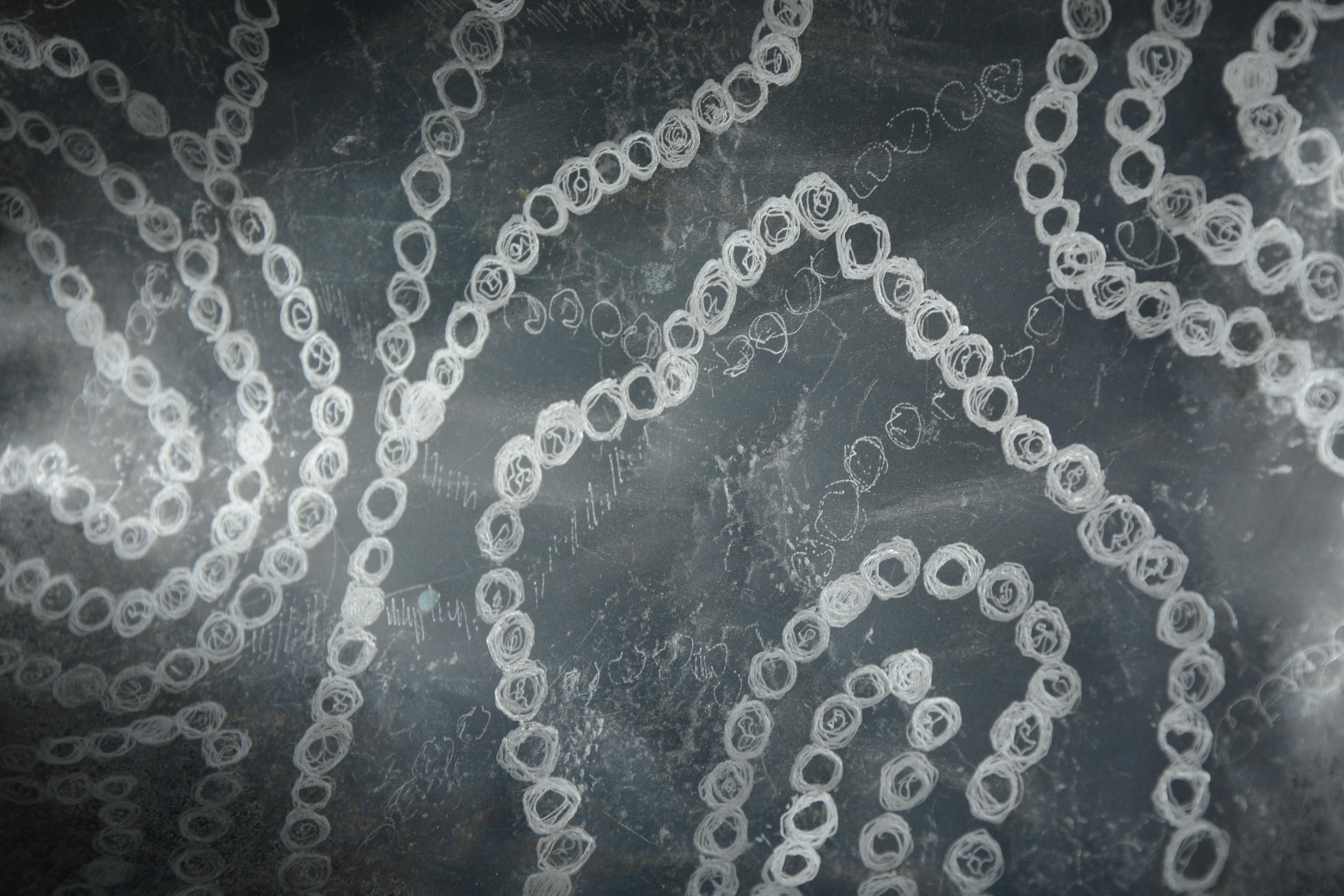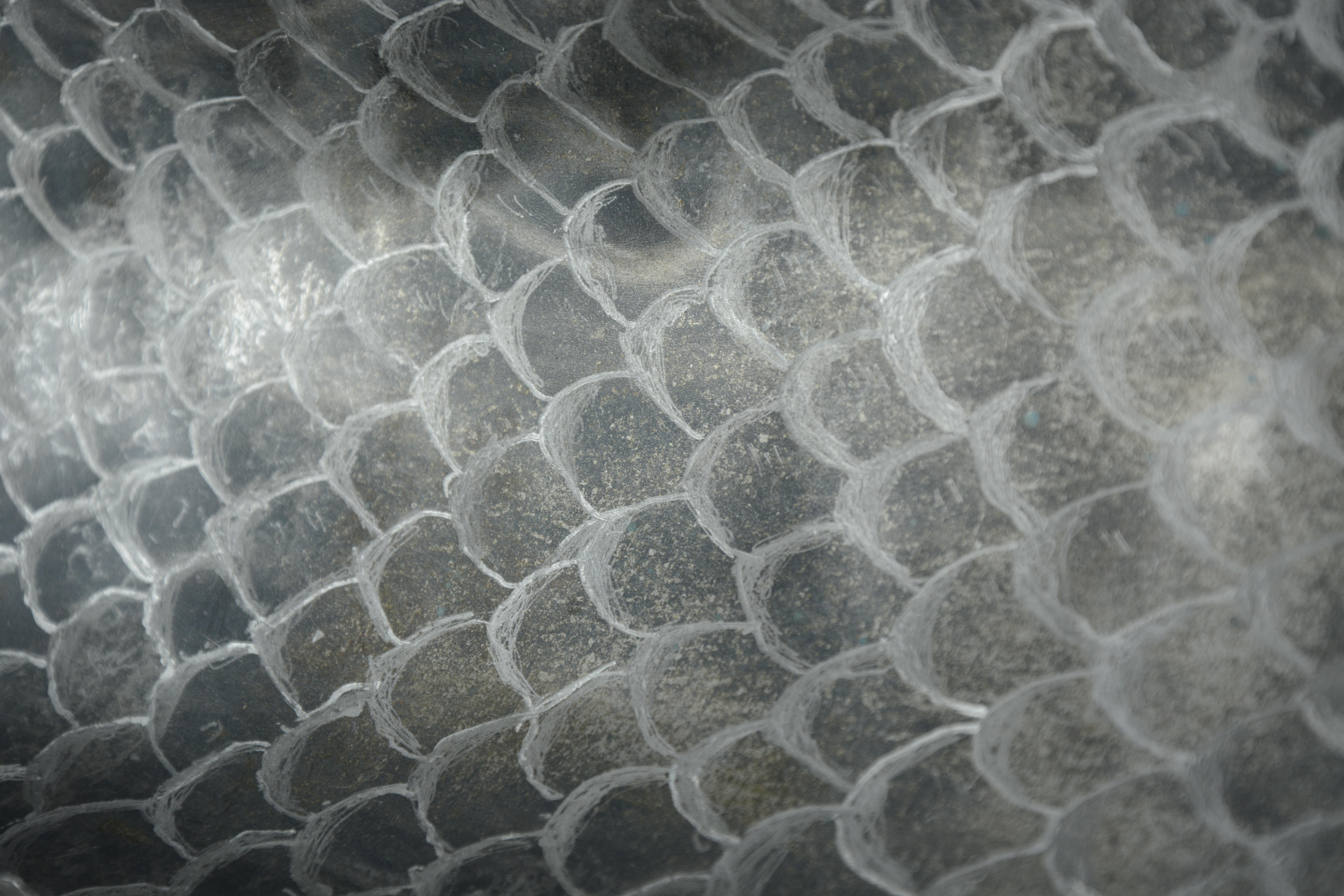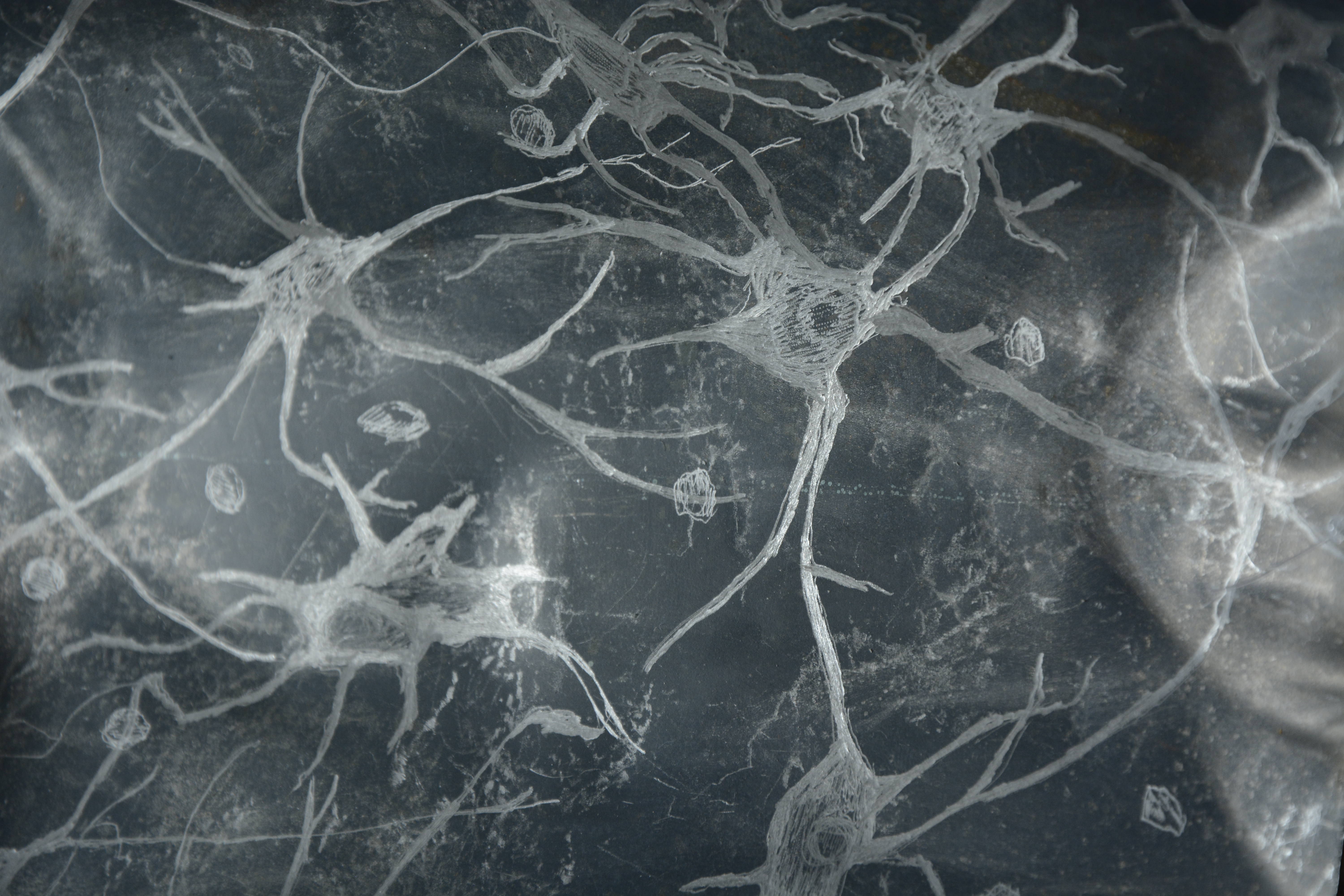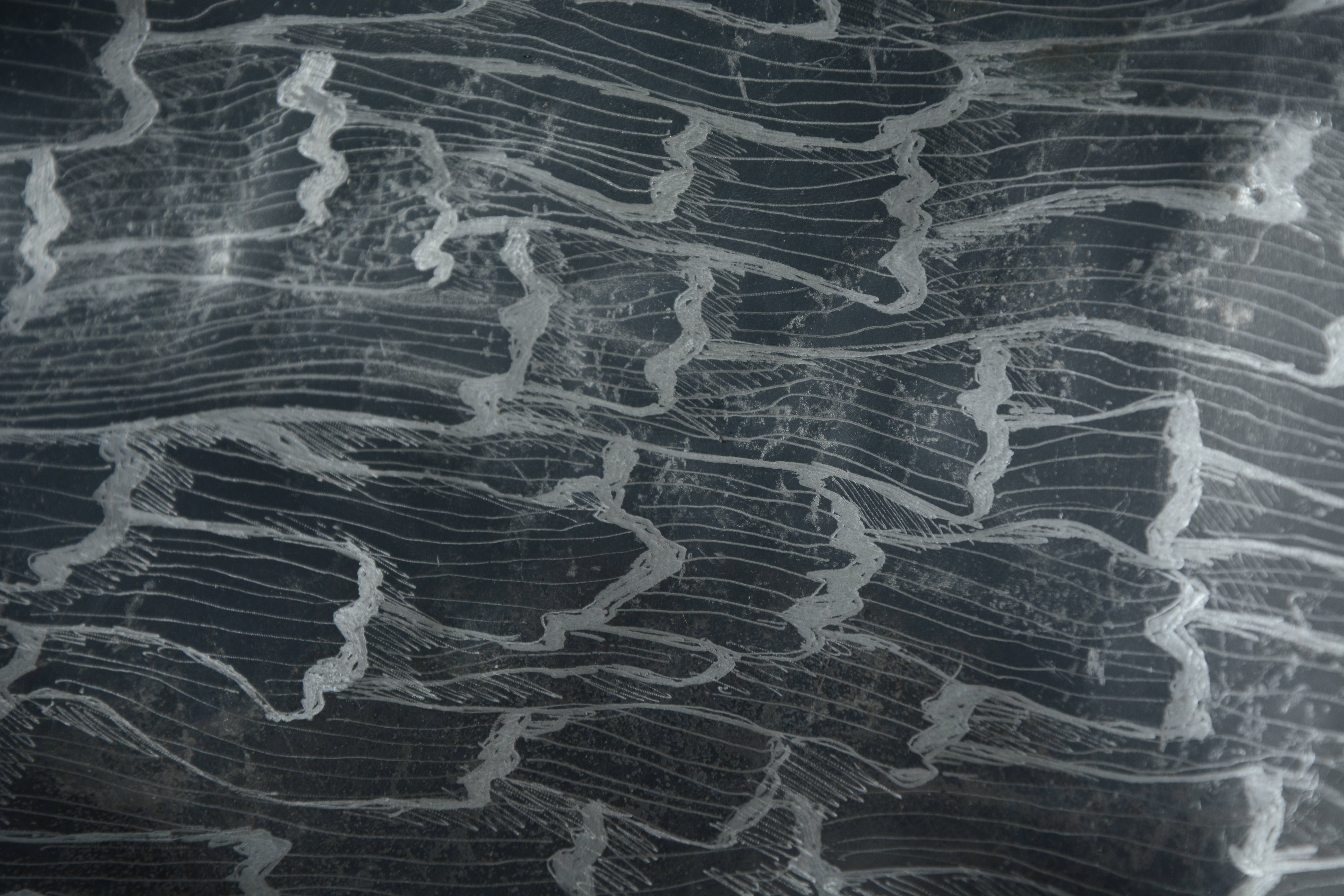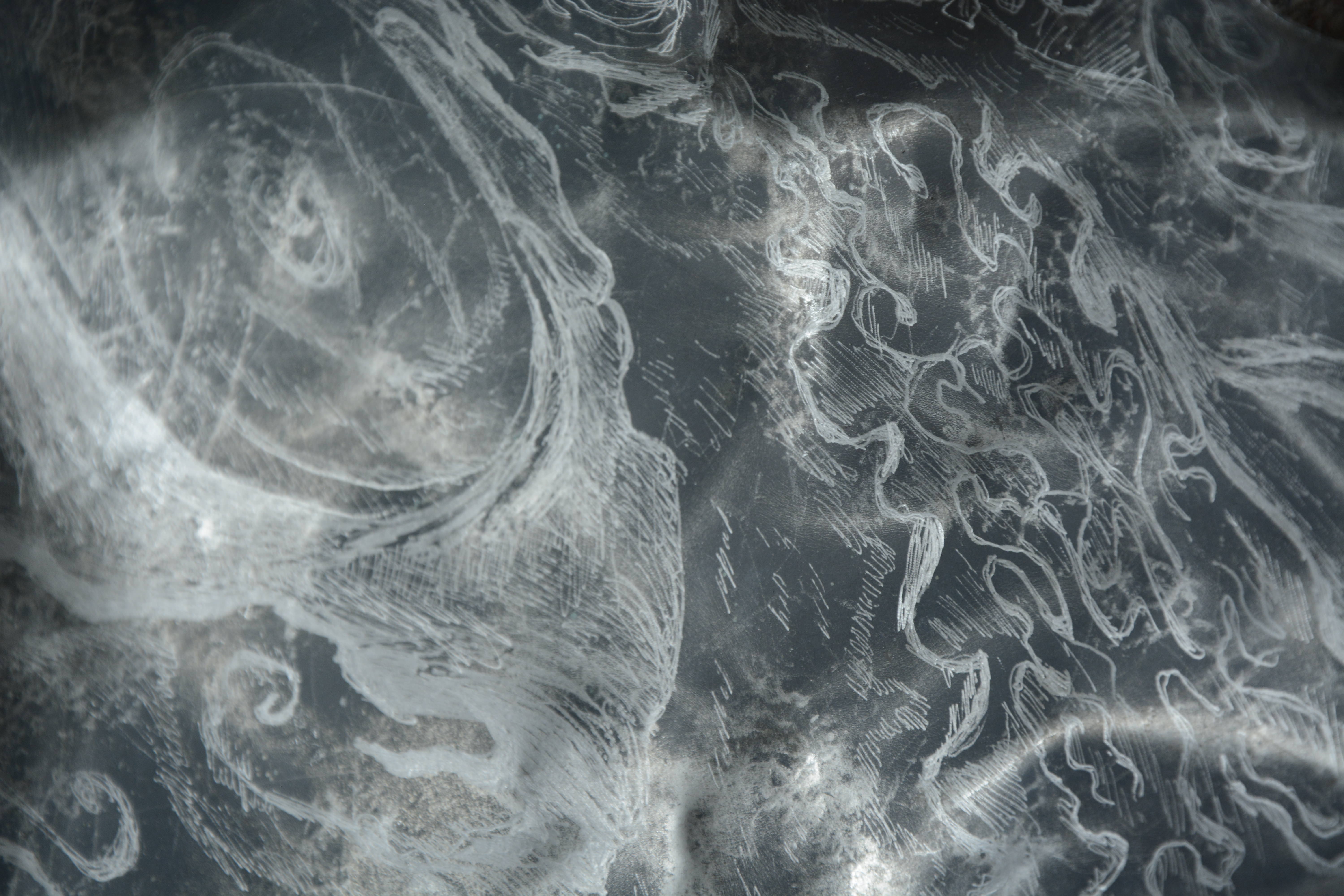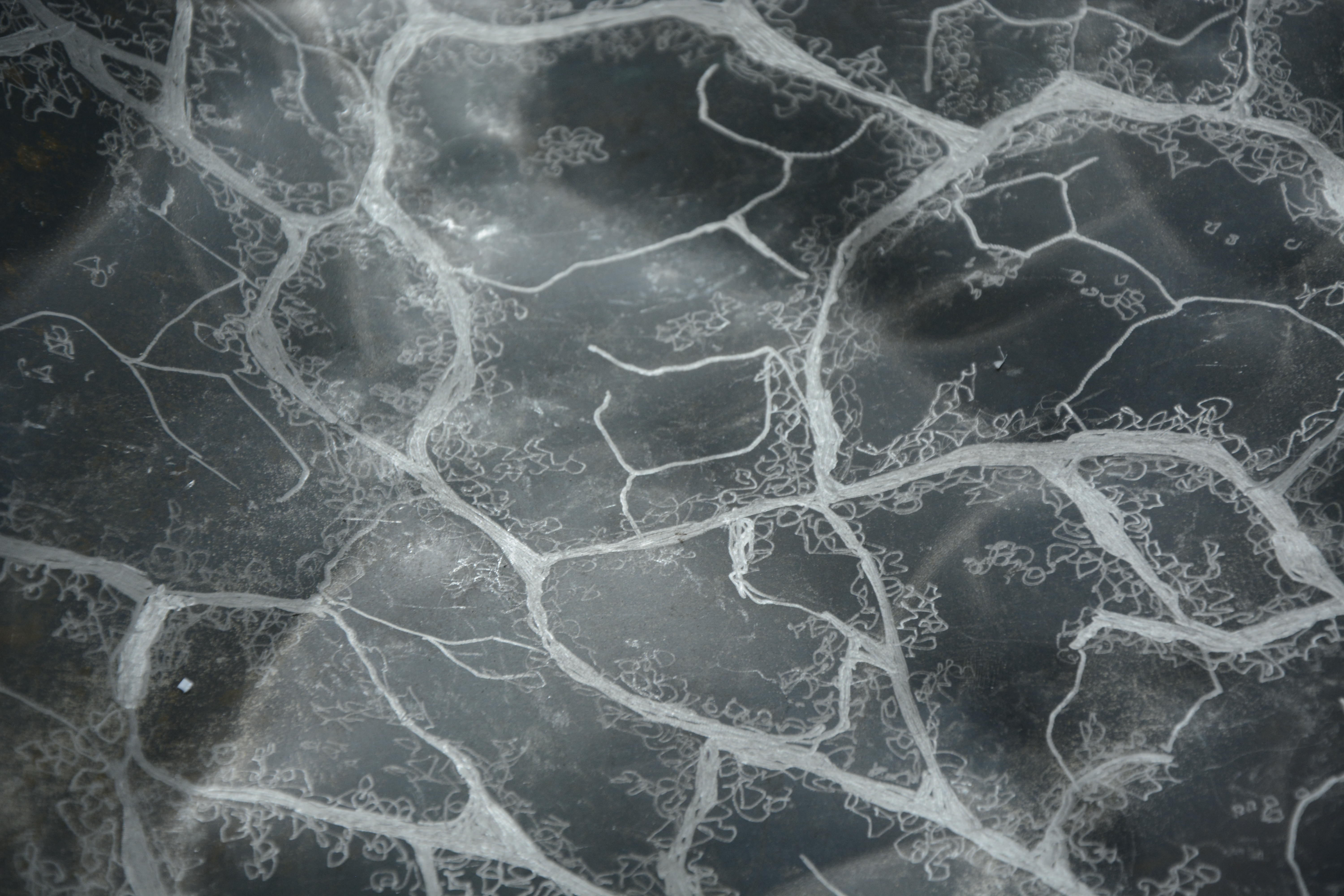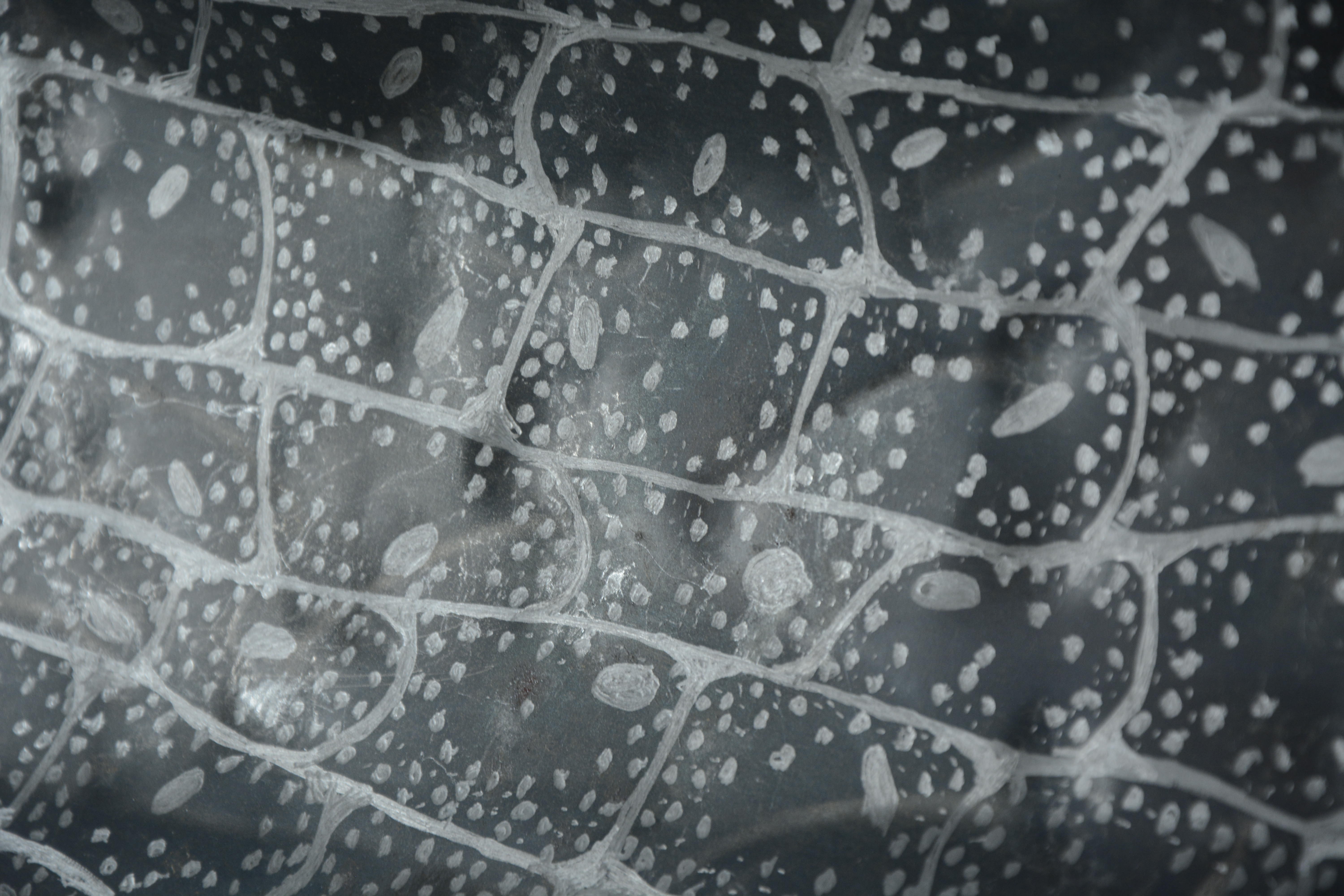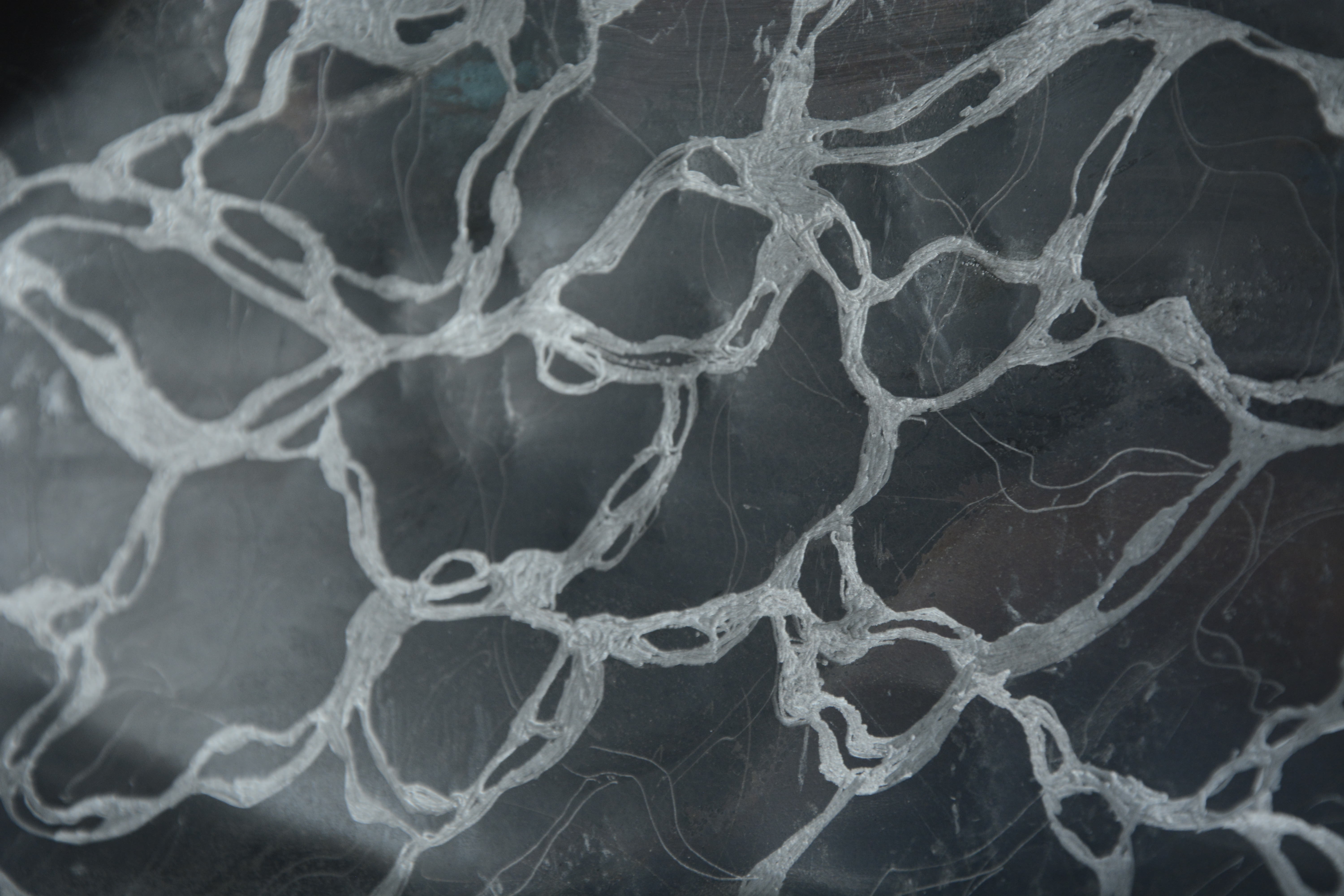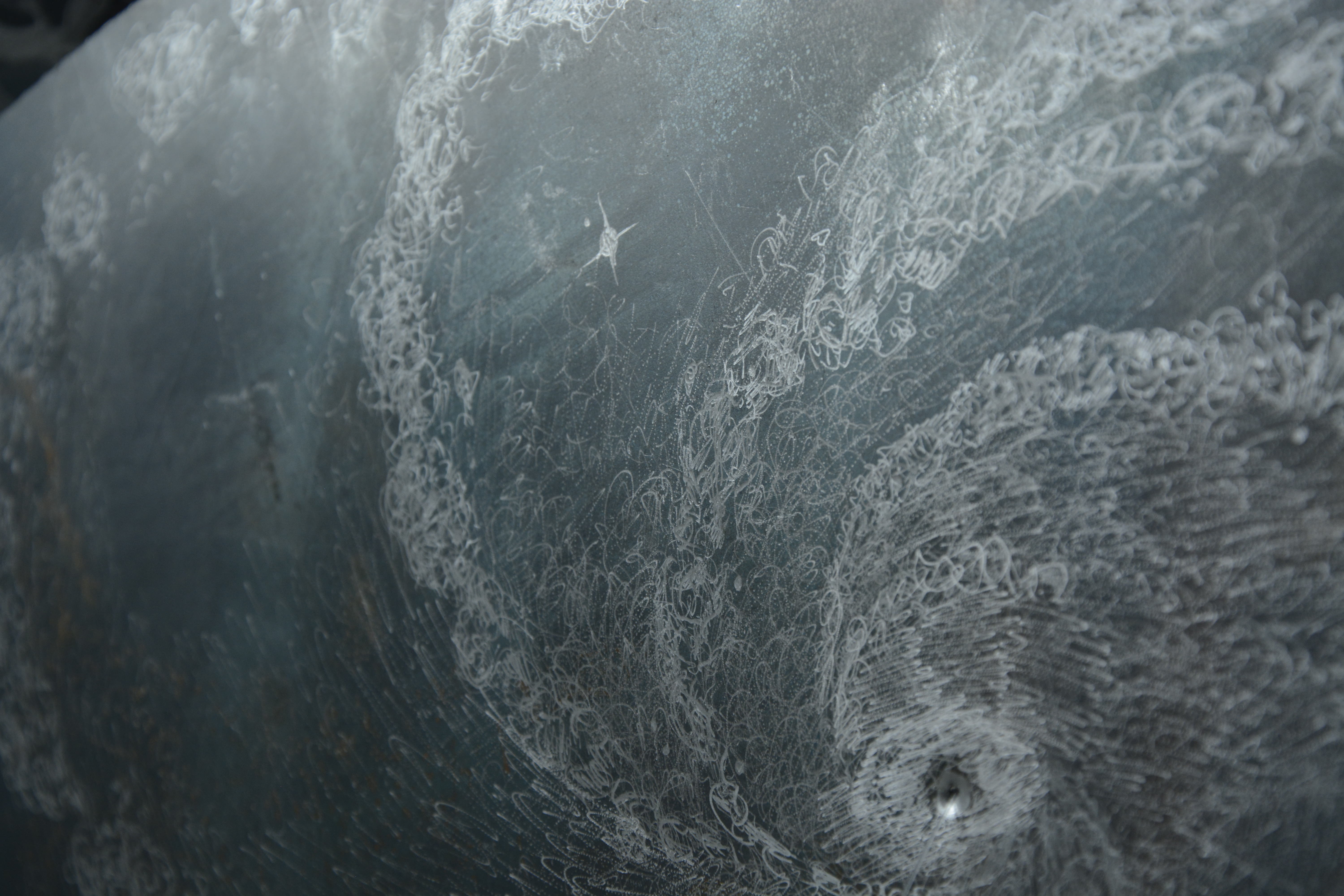Universal Flux
Holly Moore, 2022
Steel, fishing line
Dimensions: 2’6”x3’x8’5”
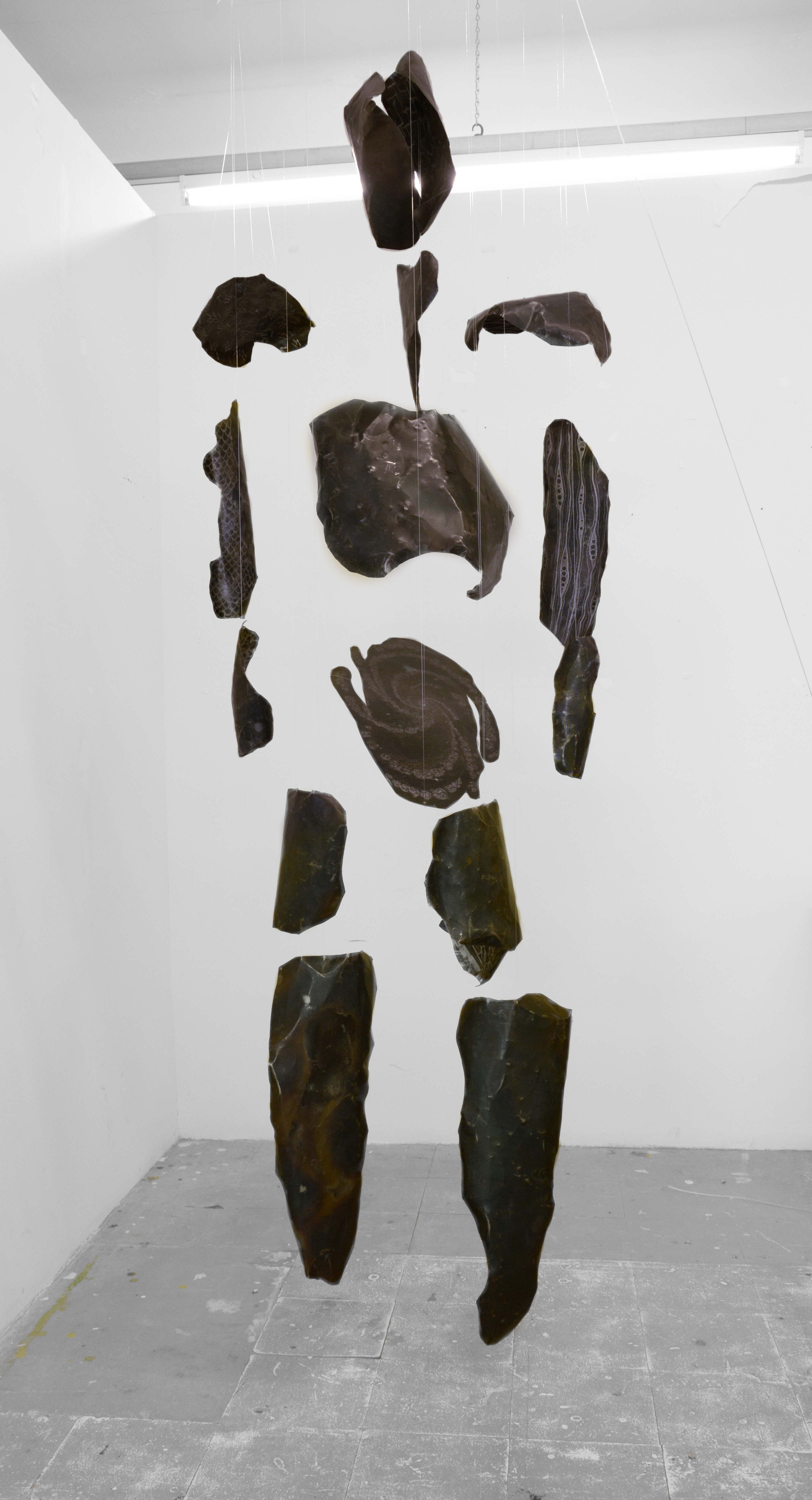
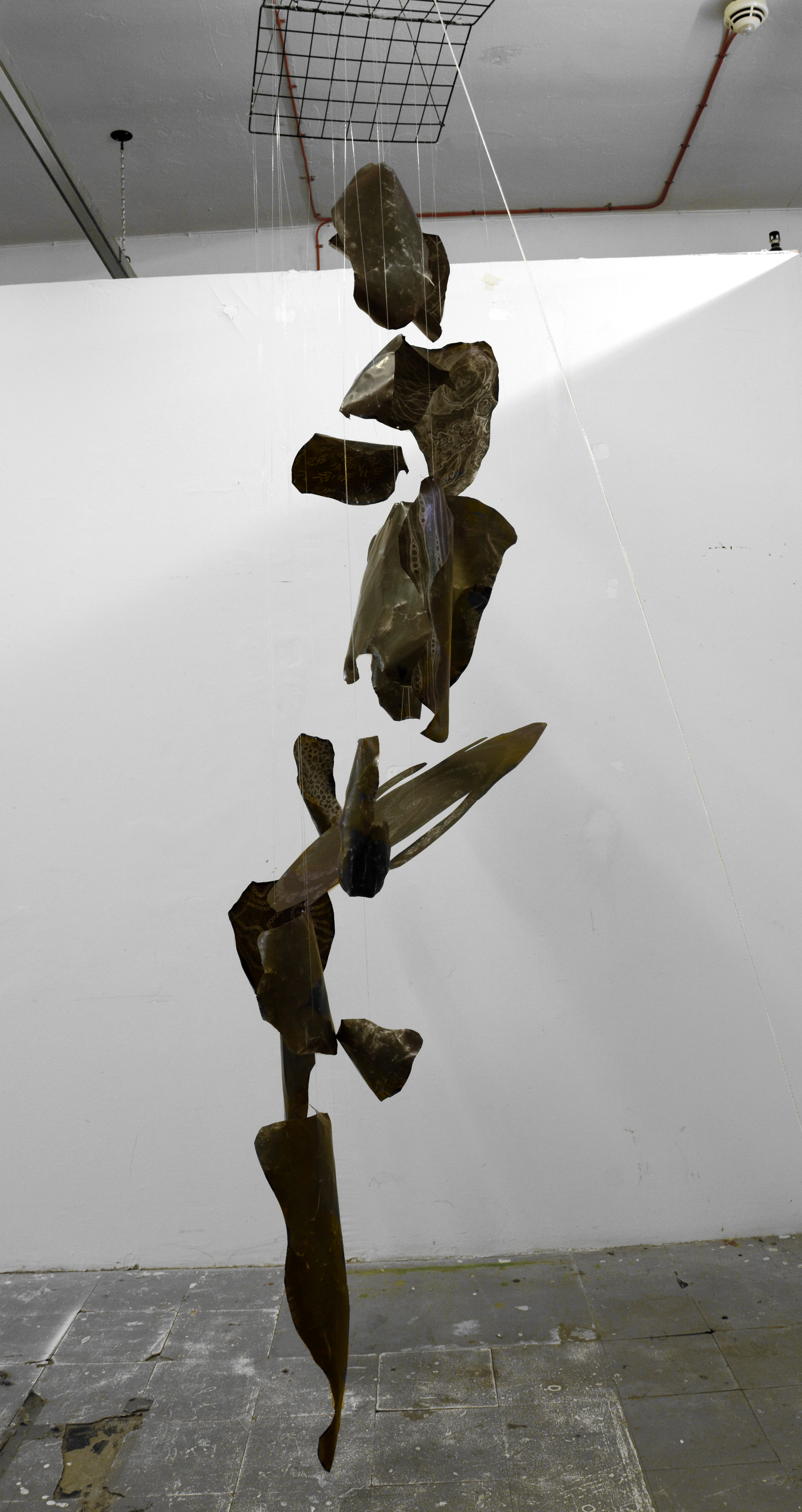
The piece is a mobile sculpture of a rough human figure, made from abstract shapes vaguely resembling different parts of the human form. The pieces have been formed into asymmetrically curved sections of steel; the convex side a mottled blue-grey, slightly iridescent steel finish with small areas of bright orange rust, and the concave side features engraved designs in a light metallic grey. A metal grid is suspended from the ceiling, and the steel pieces are suspended from the grid with clear fishing line. The pieces spin organically when the sculpture is moved or a slight movement in the air occurs, and when the pieces make contact with each other, a gentle metallic chime sounds out.
The designs on the pieces have been hand engraved with abstract patterns, each depicting a part of the natural world – from stone, feathers, and cells under a microscope, to aerial views of landscapes, and the giant storm of Jupiter. However, the etchings are designed to distort a sense of scale – their abstractness means that they could depict the natural world at both micro and macro levels at once.
There is an almost primitive look to the sculpture, with the weathering to the steel and crude abstract human form, reminiscent of cave painting figures.
Universal Flux is a representation of the constant flux of atoms that make up our universe; moving between all elements of the natural world and connecting us intrinsically to each other, the planet we share, and the universe that surrounds us.
The work is an exploration of timings, chance, and perspective – if the pieces happen to spin into the shape of a human whilst a viewer is looking at it, then it's by chance that they happened to be there looking at the sculpture at the time when the sculpture looked like a human. Much in the same way that the atoms that exist in the universe in human form will only be in that human form for a fleeting amount of time. If a viewer happens to be standing in the right place at the right time, they see a human, but there is no ‘right time’, as traces of the human still exist in the other pieces of the sculpture, representative of the journey the atoms are continuously taking.
The spinning of the sculpture means that there is no beginning or end point; everything is in constant change and motion, mirroring the infinite cosmic dance the atoms that make up our universe are in.
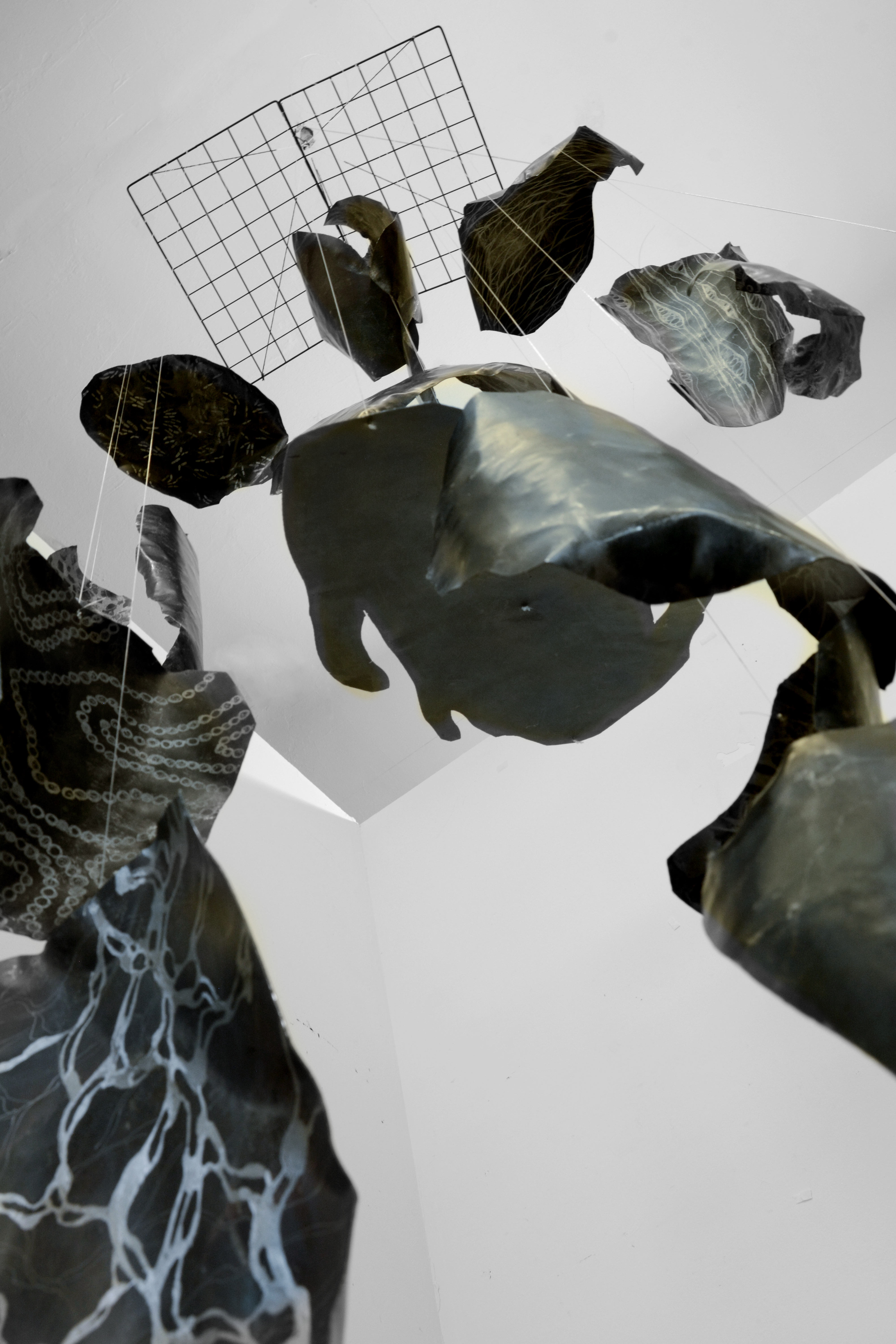
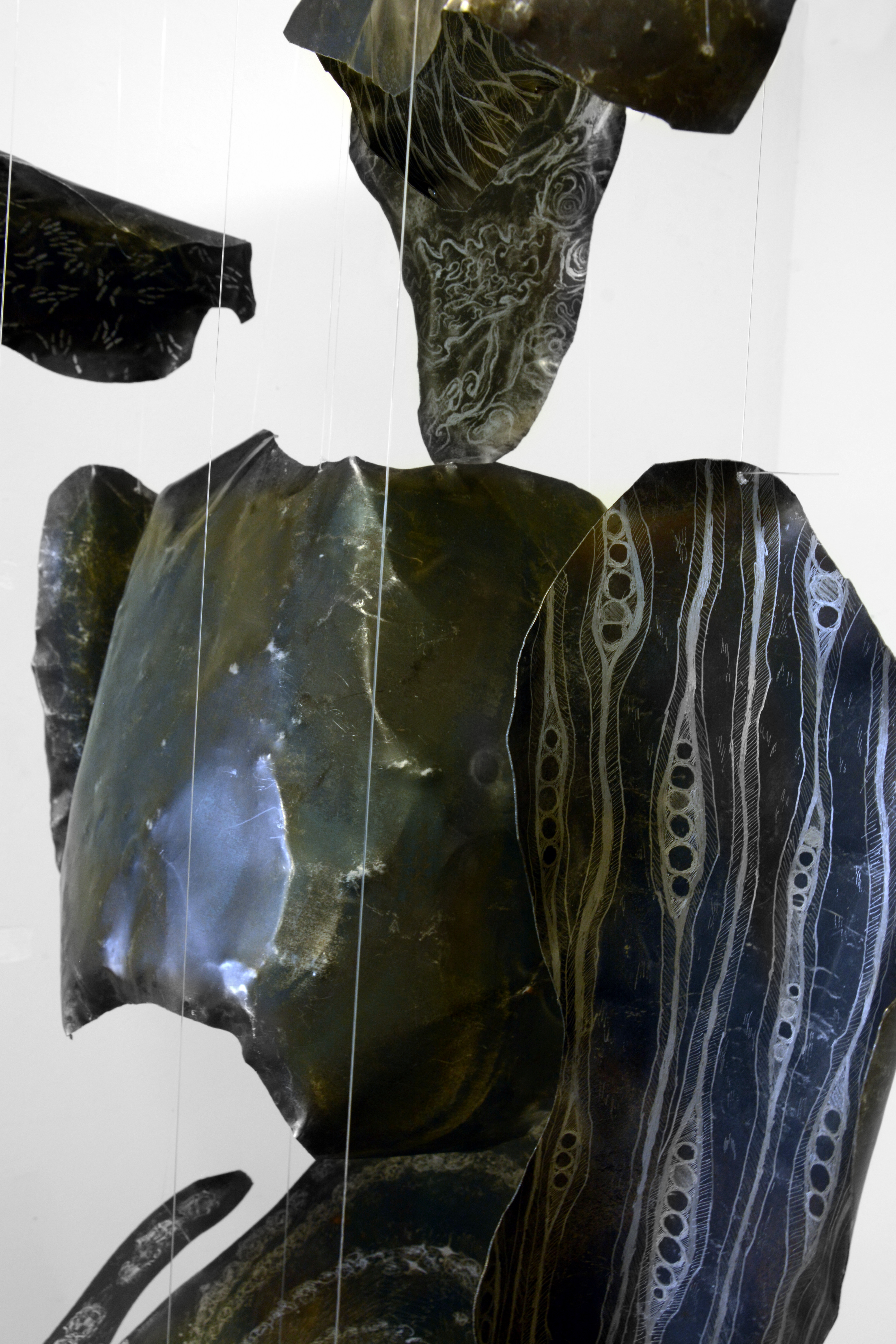
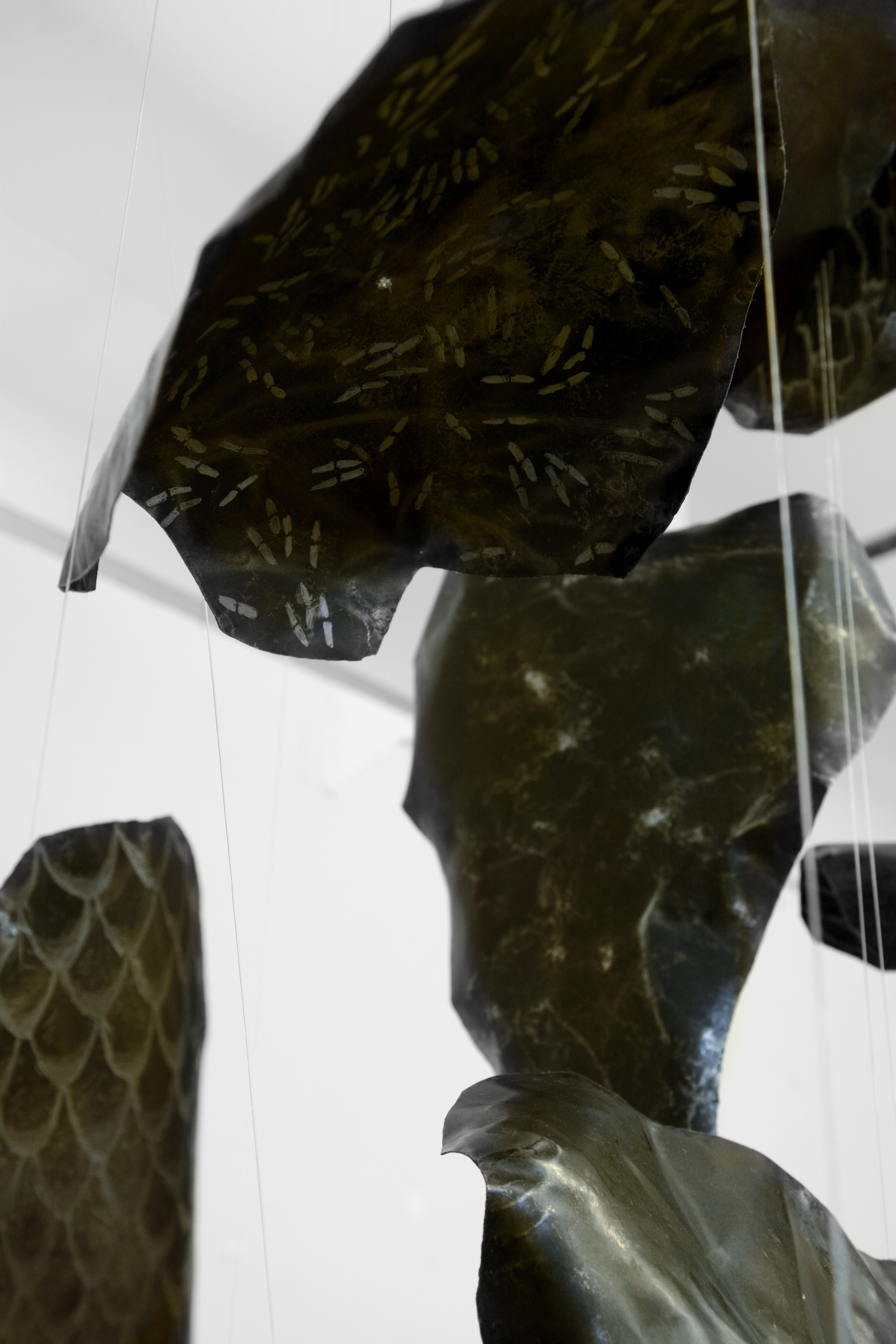
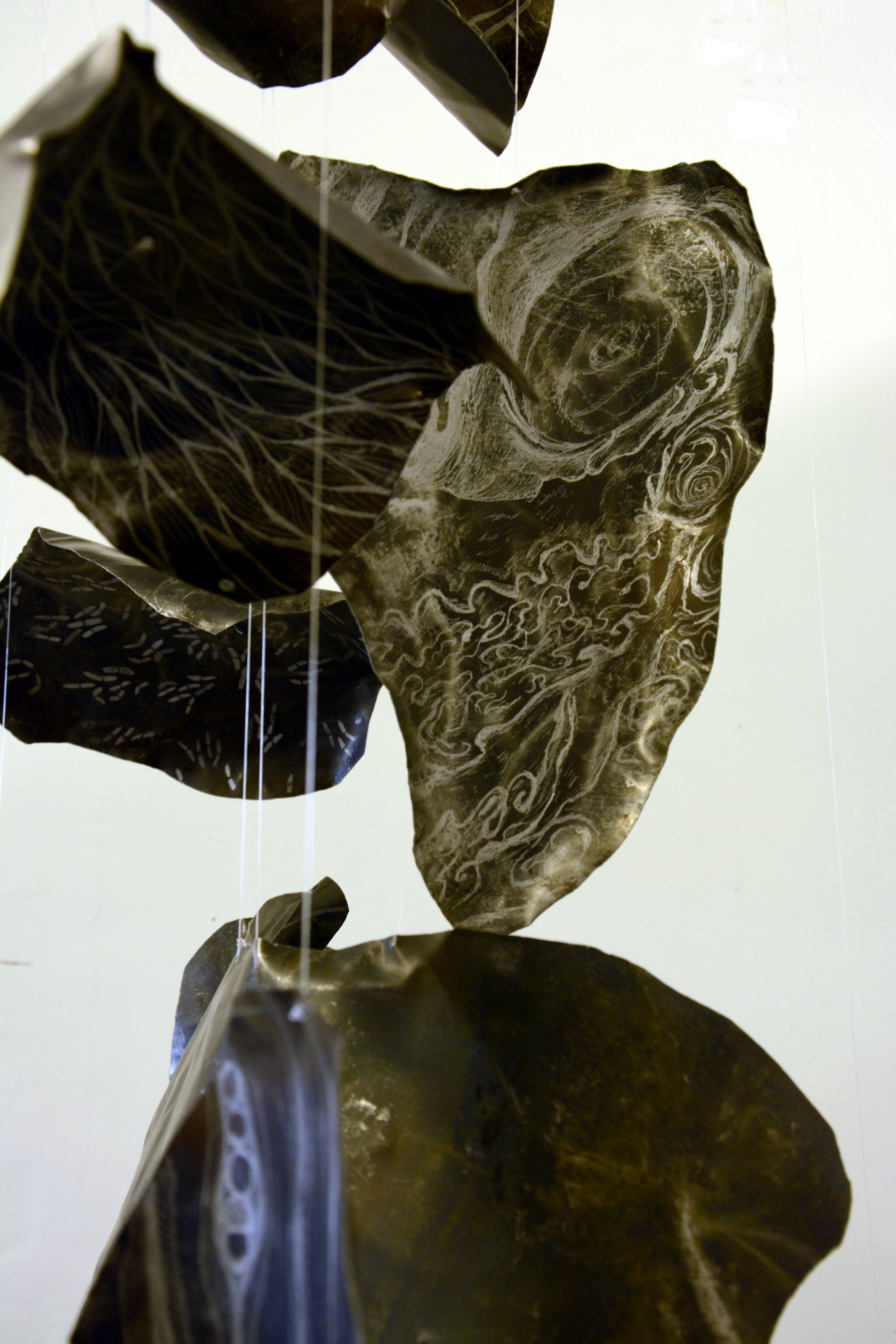
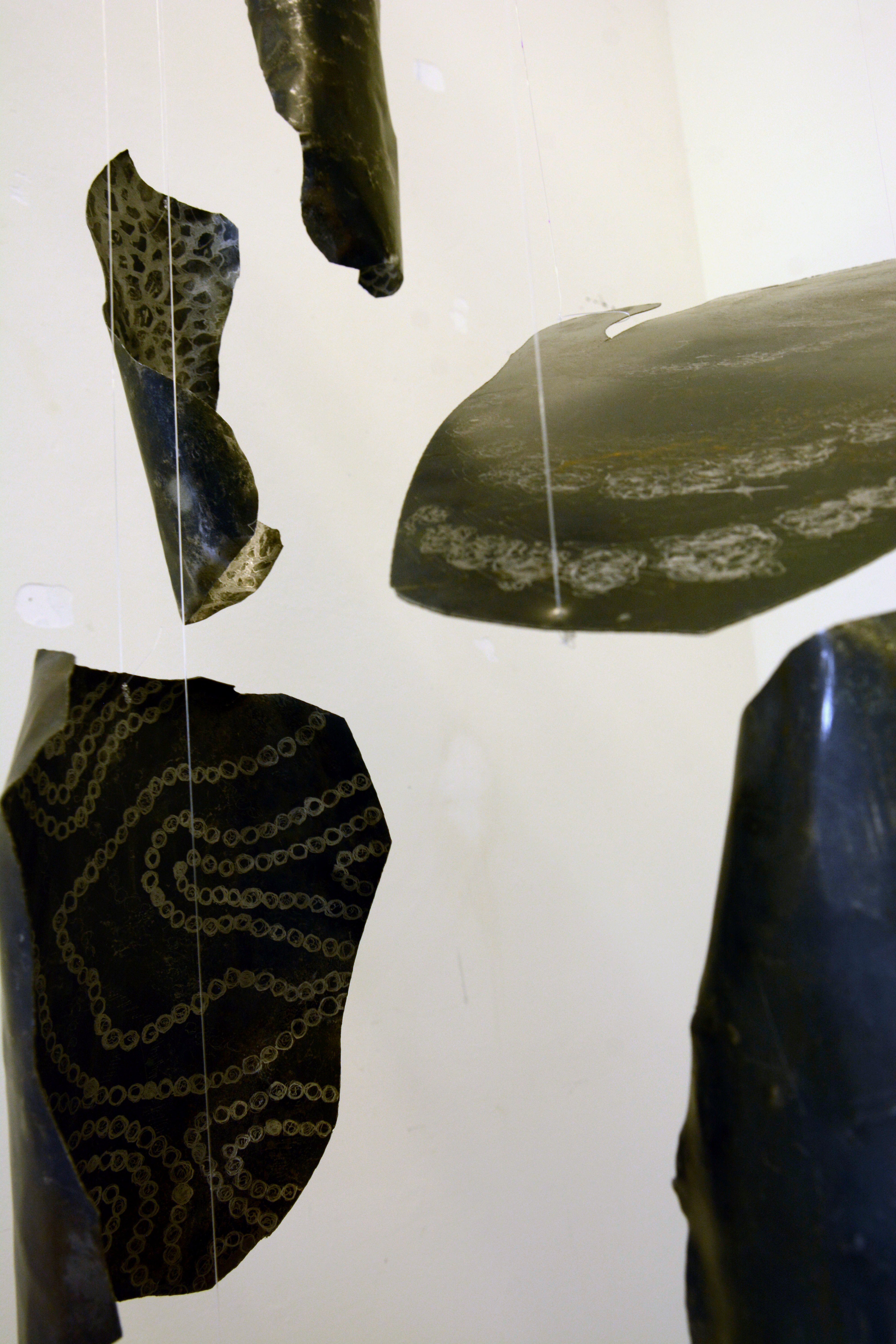
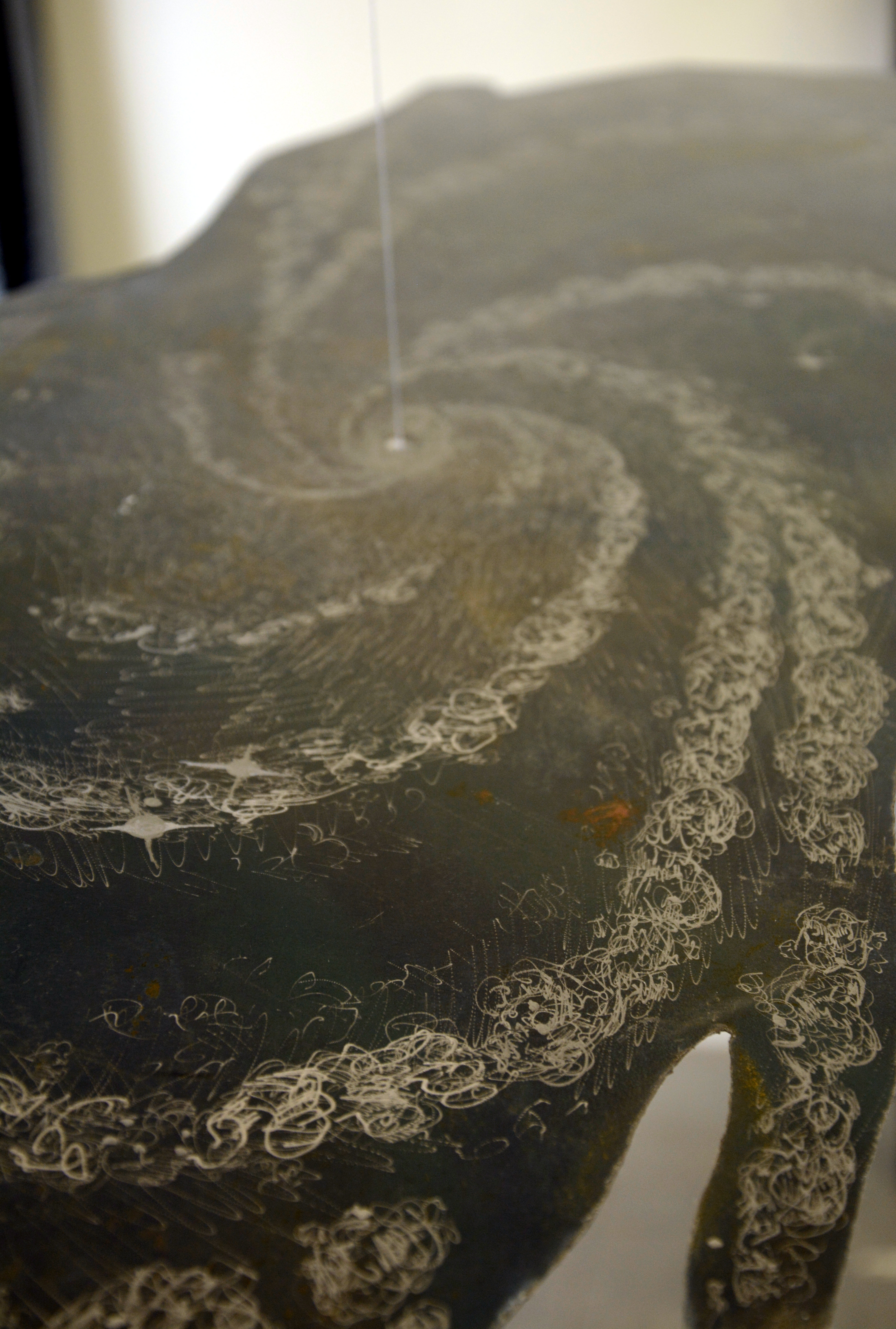
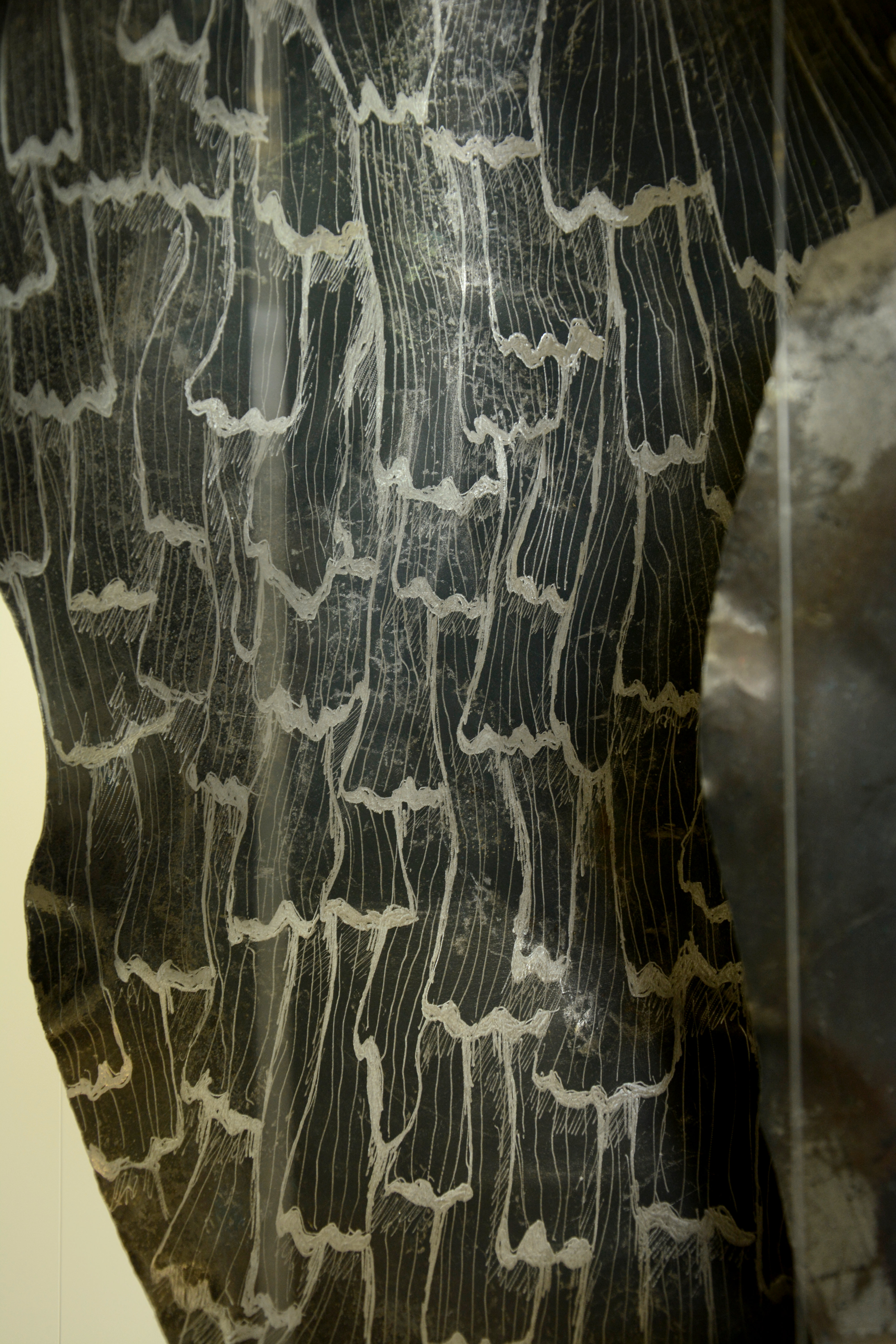
The first moments of our universe after the Big Bang were a rapid period of inflation, followed by a dense soup of leptons and quarks. As the universe cooled, the quarks were able to form together as protons and neutrons. Then, 380,000 years after this, the universe became sufficiently cool enough for electrons to be able to be trapped into orbit around these nuclei, and hydrogen and helium were formed.
Hydrogen and helium are the lightest elements, and can only be created during these specific conditions of the early universe. As a result, all of the hydrogen and helium that exists in the universe – that same hydrogen and helium that makes up a vast percentage of your body – was created around 15 billion years ago, 380,000 years after the Big Bang.
The hydrogen and helium atoms that are a part of you right now have seen the universe in its infancy.
The majority of the rest of the atoms that make up the human body were created via nuclear fusion inside the hearts of stars, or in the immense explosions of supernovae for heavier elements.
We’re built up from the remnants of stars; vast celestial objects that once burned to thousands of degrees, then detonated in as they lost the fight against gravity, flinging the atoms it created out into the universe.
As a consequence, you as a human being are a mix of something so archaic and something so new to the experience of life, mixed up in the same body; a tiny part of the universe that can feel, and see itself, discover itself through the eyes of something so small.
Not only this, but as far as we know, living inhabitants of Earth are the only part of the universe that can feel and think and comprehend what it is like to inhabit something with intelligent consciousness.
But these atoms that form our bodies are in a continual state of flux. We lose and regain atoms as we grow and age, take in food and drink or breathe in and out.
The body you inhabit now, as you read this, is almost a completely different composition from your body only just a few years ago. What we are made of is continually flowing from one thing to another – the atoms that existed in the bodies of past humans and animals and dinosaurs and every aspect of the world exist in ours now, just as they exist in the animals and nature around us – we are all connected.
Nothing we have is ever ours for very long, but what we do have we share with everything, and everything that exists is a part of this same interchanging of atoms and energy. It’s a closed circuit of matter and energy.
Thinking about where humanity sits in the grand scheme of things: the world has never belonged to us, we have always been a part of the world and the universe that extends beyond it. We are just another facet of a bigger thing, but no less important than the astronomical. The vast scale of the universe seems far away, but it’s intrinsically bound up within ourselves, in the atoms that combine to give us a physical place in the universe.
What have the particles in you been? How far have they travelled through the universe, to fleetingly add you to the list of things they have become?
Inside you are things unfathomably archaic. Parts of you have experienced being stars and galaxies, meteors and dinosaurs, early humans that lived lives we can only guess at from the things they left behind.
The energy that forms your thoughts and consciousness, the brain waves that define your complexity and mark you as a unique part of the universe experiencing life have also existed since the birth of the universe – a universe where energy is conserved, only shifting into different forms. The energy that forms your consciousness will always be a part of the universe; always has been.
And, when this consciousness slips away from the body that contains it, dissipating into other forms of energy, giving life to something else, the atoms also begin again in their billions of forms, their billions of different variations of life. To be passed on from you for the last time, but the consciousness that borrowed them for so short a span will always remain a part of their history, to live endlessly on in other parts of the universe.
Maybe ‘you’ as a concept is something new, with your unique memories and experiences; something that has never existed in the universe before you were born. But the body you define yourself with, the body you will own until you die and it decays back into the Earth, is made of atoms that were formed in universe creating explosions, fusion at thousands of degrees, and supernovae.
Those hydrogen atoms that formed at the beginning of the universe would one day hold a life and intelligence that could understand what it was made of, that still carries with it this aeonic history – an explosion that saw atoms form and tear apart, saw the formations of the first galaxies and the first stars and the first planets, saw something spiral into something more and more refined, more complex, more life – you were there to experience it all.
We all were.
